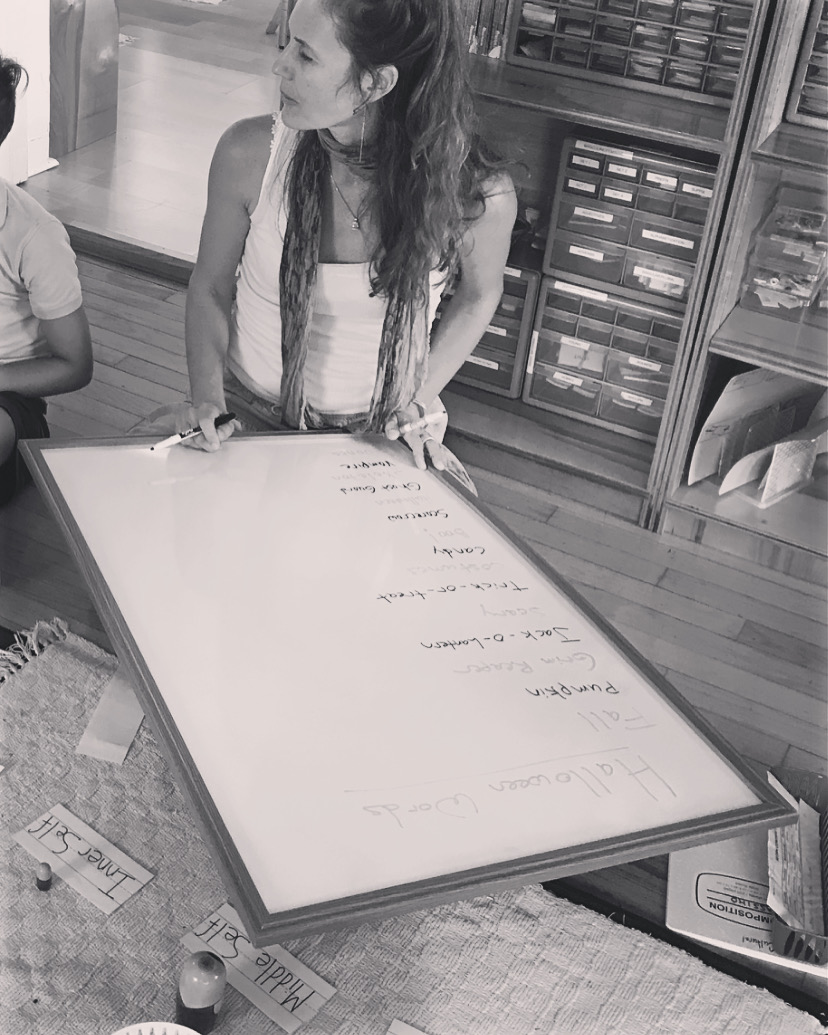Sarah, eight, came rushing toward me with a look of distress on her face.
“Ms. Elizabeth, Charlie took the seat by the window and I asked him if I could have it and he said, ‘No.’”
I took a deep breath and scanned my body for how I felt at that moment. Nothing came up. I was feeling connected to myself and grounded in myself, and I could hold space for Sarah.
I said to Sarah, “Did you take care of yourself? Did you tell Charlie how you felt?”
“Yes, Ms. Elizabeth. I told him how I felt and he still didn’t move.”
“Okay,” I said, “How can I support you right now, Sarah?”
“Can you please make him move?”
We walked into the classroom and up to Charlie, who was working quite peacefully at the window. Sarah said to him, “Charlie, I feel sad because I wanted to sit at that table and I don’t get to sit there often and I told you how I feel and you didn’t move.”
Charlie responded, “Well, I haven’t sat here in a long time and I want to sit here. I feel happy sitting here.”
Sarah scowled and turned to me for assistance.
At that point, as a teacher, I could have intervened. I could have proceeded with a myriad of options, enforcing my power and making Charlie move or ushering Sarah to “get over it” and onto her academic work.
However, in that moment, I realized that giving the students the space they needed to process their feelings and to create the connection with Sarah about what she needed for support was Social Emotional Learning (SEL) in action.
In a society so focused on production, output, and getting through work, this was where the magic of life existed. In the uncomfortable, nuisance-filled moments when students felt and navigated emotional reactions.
I have been an educator for more than 20 years, with practical “in-class” experience. I have taught a myriad of courses to future teachers, and the most common questions I receive are how to “manage” classrooms and how to “manage” behavior.
First and foremost, using the term “behavior” places the understanding that this is something that happens outside of “us” or outside of the teacher—when, in fact, it is not. As we know well, what we see in others is a reflection of ourselves. Therefore, in order for us to hold space for our students, we must first be solidly grounded in ourselves and connected to ourselves.
We have been conditioned, as teachers, to not let anything stand in our way of getting our job done or disseminating information to our students, so that we can feel accomplished for “teaching” our students academics. We are conditioned to focus on outcome. Behavior is just a “nuisance” that gets in our way. So the question in the old paradigm has been, “How can we deal with this behavior so we can move onto the more important academic topics?”
But this is where we are wrong.
I realized, when helping Sarah and Charlie, that behavior in the classroom was not a nuisance.
It was the essence of life.
Traditionally, SEL is a curriculum that is “sprinkled” on top of the academic curriculum. There are a plethora of amazing programs that schools and teachers can adopt, as well as integrating reading books and discussing emotions in the classroom.
However, the actual practice of integrating this knowledge happens in the moment. As teachers, we are blessed with more than enough moments throughout the day to stop and be with our students to guide them through what they are experiencing.
SEL is not something that is just added as an “additional source” to the curriculum; it is the school day, it is the moment of conflict that arises between the students, it is the moment of discomfort I feel when I choose to give space to my students to discuss an issue, instead of moving past it and onto academic work.
What SEL cannot teach is the feeling of connection.
Connection to others begins with a connection to yourself. How are you feeling in your body at the moment? What can your nervous system take on?
If you notice above, before I connected with Sarah to facilitate her conflict, I dropped into my own body and connected to myself.
There is a level of self-preservation that, as educators, we must embody. We cannot take it all on.
We can only take and guide others as far as we have gone ourselves. How much can you sit in discomfort? How much can you sit in the unknown? How can you hold space for yourself? How far are you willing to go to uncover your own conditioning, to do your own work?
This is the new paradigm of learning—where the goal of education is not academics, the goal is connection. Connection to self, connection to others. When we feel connected with others, we feel seen, we feel heard, and we flourish.
Imagine a school system where the emphasis and goal was not on academics, production, and output, but on connection. Where students learned the meaning of connection through feeling it in the classroom.
Teachers, this begins with you.
Can you be a leader in facilitating connection to yourself? And in the classroom?
The circumstance above between Sarah and Charlie continued for about 20 minutes. Before Charlie went back to his work, I validated both of their feelings and brought in the concept of perspectives. Whatever they were feeling at that moment was valid for both Charlie and Sarah. Specifically, it was fine for Sarah to have different feelings than Charlie, and their different feelings did not negate each other. They both had a right to feel.
Charlie went on with his work, content in his decision to stay in his seat. I sat with Sarah, giving her the space to feel and process her feelings. I sat in her discomfort with her, and I noticed how many times my desire arose to move her onto her work. Each time that feeling arose within me, I acknowledged it and told myself: Just a bit more. Let her sit with this a little longer.
What Sarah walked away with from that experience was what it felt like to be disappointed, feel uncomfortable, and not get her way. She was able to experience these feelings in a safe place, connected with me in that moment. She was not alone; she was not shamed; she was heard and seen. Her brain was able to make the neural pathway connection of what it felt like to be supported and held in a difficult moment.
This is life.
This is where the magic exists.
Connection to self.
Connection to others.
Connection, connection, connection—this is social emotional learning for the new era.







Read 2 comments and reply